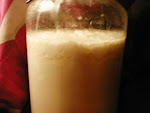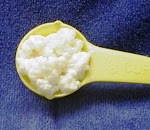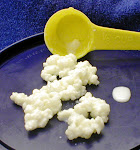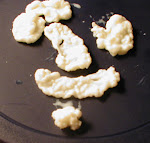Visit My Website and Virtual Store http://www.bacteriapimp.com
Kefir True Life Files From The Desk Of The Bacteriapimp
Then what is 9:1 ratio? If you use 1oz grains to 9oz milk.......then 1/2 c grains (4oz) to 36oz milk? I do pour the cold kefired milk (grains are in this) into my drinkable kefir. Though mine is not tasteless- it is tangy. My grains have multiplied though they are still small-ish- smaller than cottage cheese- 1 or 2 larger ones. Should I let them "rest" on the counter instead of the refrigerator, and if so, for how long?
Thanks for your help- much appreciated.
Exactly or somewhere around there. 7 to 1, 10 to 1, or even 12 to 1 whatever you find you like at those ratios will be fine with the grains and is what I have read is more ideal for fermentation. Do you ferment in the refrigerator all the time? That is not ideal, you ferment at room temp and that room temp should be as high as possible like high 70's and beyond. In the winter for proper fermentation if you live in a cold climate you will need heating pads. I will be offering them on eBay in a few months by the way.
The deal with fermenting with milk grains is they need at least 18 hours to 36 hours at room temperature; you have to figure out how long they need by looking at them and just getting a feel for what they are at that point. Then when you feel they are done and hopefully the grains will contact you telepathically and let you know, you still don't have to put them in the refrigerator, you can strain out the grains put them in the next batch or rest them in milk in the refrigerator and leave the result of the fermentation on the counter. It will ripen a little more, it certainly won't go bad. Putting it in the refrigerator after straining is an option you can choose but I recommend consuming the result within 3 days that is my personal preference, something a swami guy told me about its life force (prana) sounds real to me. If this does not answer all your questions get back to me and ask some more.
The size thing is interesting, I can' t really answer because I don't have enough information about exactly what you are doing there, but if they are growing that is a good sign. When they get very big you must pull them apart with your fingers; you don't mention flat grains which is good although flat grains are not that bad but they are a natural occurrence and they can grow to be the size of my hand and I have a big fat hand.
Here is what should happen when you ferment with healthy active grains. In about the first 6 hours sitting at a good room temperature the grains should sort of pull the milk up about them selves and form a think coating around themselves, the solution is now becoming more acidic which is allowing other reactions to start in the mixture, next you will see a clear or yellowish liquid forming within or just below the thickened grains. That is kefiran and that is a very good sign. Your grains should double in size within 2 weeks and if they don’t it might be cause for concern. Make sure you shake or mix your solution as much as possible.... I am here, ask me more questions. You are in like Montana aren't you? Do they have a Hadassah chapter up there? How is the weather?.... your bacterip.... Your Bacteriapimp
_____________________________________________________________________
hi just bought some water kefir grains and cant wait to get them. i was using the milk kefir but noone likes it but me so i thought i would try the water kefir. Any way i would like to try making the coconut kefir how would i do that? That would be after i bring them back to life
The tricky part of fermenting young green coconut water with kefir water crystals is finding the coconut water, the rest is easy. If you have access to fresh young green coconut water just add about a 1/3 of a cup of the grains to a quart of coconut water. I do a cup to a gallon and I get great results. I would give the grains a treat once in a while and give them a break from the coconut water and let them ferment something else like some baking soda and some coral calcium and some ginger juice in some sugared water with some lemon peel in it or ferment some grape juice once in a while to give the grains a nutritional boost and change. I love coconut water kefir but a lot of people don't like that either but they do love grape and berry type fermented juices. They taste like soda and they are sweet. You can catch more flies with sugar than something or other. Milk kefir is not great tasting but it is more like a medicine and all someone needs when they are healthy is 4 ounces in the morning and 4 at night, don't try to pass it off as something that taste good. It is the most powerful probiotic I believe. And try some kombucha, that tastes really good but it is not versatile like water kefir. I will be selling kombucha again next month... let me know how it goes..... Your Bacteriapimp
______________________________________________________________
Thanks for all your trouble, I will let you know how I get on, The black grape jusice won't them go red, will it? I want clear.You have been really good thank you again
If you ferment with dark grape juice the grains will get a very red result but that will fade in time as you use different solutions to sweeten so if you use white sugar the will lighten again.
Yes, the crystals will be clear. If you use white sugar they will stay clear, if you use brown sugar they will turn brown. It doesn't really matter their color so much.
________________________________________________________________
I am going away for 10 days, what can I do with my grains?
10 days hmmmmm that is border line, put them in the refrigerator in spring water with a 3% solution of sugar. When you get back put them in some organic grape juice. That should be o.k., anymore than 10 days and I would dehydrate them so don't neglect them when you get back put them in the juice right away... have a good time Your Bacteria Pimp
_______________________________________________________________
Hi,
I have water kefir myself and in need of some advices. I use regular process, spring water, dried prune, sugar cane, a piece of ginger and a slice of lemon. This goes well but I am looking for some variety. Do you have other methods of preparing the fermentation water? I read your blog mentioning berry juices so I am thinking of some breakfast juices, will that work?
Thank you for your time
Hi, you sound like you pretty much know whats going on. I'll tell you what I have been doing lately that has to do with dark grape juice and dark berry juice, organic of course. First I have 3 four liter jars and one 5 liter jar fermenting things. I have an order for a gallon of coconut water and the grains like coconut water too, some people don't like coconut water at all, I love it and I love kefirated coconut water. I have about a 3/4 gallon of mango juice cooking while the other two jars are brewing more or less lemon peel and sugar. The only difference between the two lemon peel jars is one has crystals that were fermenting coconut water all week and the other came out of the refrigerator after sitting in it dehydrated for about a month and then sitting on my desk under the lamp for 2 weeks. I took the dehydrated grains, about an 1/8 of a cup, and put them in 48 ounces of concord grape juice. It took over 24 hours for them to start to get going. I know when they start up because I use bail wire jars with the rubber gaskets and when you open one that is fermenting like it should it makes a frarummmph noise, right?
So what is interesting is that when I took the grains out of the grape juice and put them in a jar with lemon peel and sugar solution at the same time I took the grains that had been fermenting the coconut water also into another lemon peel and sugar solution,
I put the jars next to each other. 12 hours later I opened both jars and the grape juice crystals which have only been through one recovery cycle gave a stronger frarummmph by far than the regular cycled coconut water crystals. It makes me believe that grape juice and also dark berry juice because I noticed more or less the same thing with them, have special nutrients or something that make the grains really strong. Plus I love the taste. What I advocate is the idea that you can brew for yourself and you can also brew for the grains as there are solutions like some with lots of ginger juice, so much you would not like it but the grains might like it, and or the baking soda and or the coral calcium pill. So you brew for the grains once in a while, something you are not gonna drink; I think that grape juice or the berry juice is special and even then I don't like my fermentations so strong, so I like a short fermentation and the grains need long but not too long fermentations ( I fear brewing over 60 hours, I have to experiment and see what happens with long fermentations one of these days) I don't know what breakfast juices are but I know some people have fermented orange juice, I never had, I have alway been afraid of fermenting citrus. What I do with the lemon and sugar solution is add lemon juice or grapefruit juice later. Another thing you can do is add figs, dates, raisins etc in a food grade pouch. I don't like dried appricots, they smell bad. I would like to try and carrot juice and wheatgrass mixed with apple juice but I have too many orders and not enough time. Everyone wants the young coconut water and I just make so much money on it I can't say no, some times I have 5 4 and 5 liter jars going with coconut water, the stuff is magical. I would like to try and ferment bitter melon if it doesn't kill the grains. Are you familar with bitter melon. it is bitter and it makes you blood sugar go down so fast I think it can kill someone. Interesting stuff huh? Hey ask specific questions and what I don't know I will try and find out but I think you know as much as I do already.
Let me ask you, do they have a lot of people selling water cyrstals in where you are? I just figured out the new postal rates here in the states and I can mail grains almost anywhere in the world for 2 or 3 american bucks now. The have almost none in the UK and I just started running an eBay listing there today. Last thing, do you mind if I reprint portions of our questions and answers on my blog? Let me know what you think .....Your Bacteriapimp
_______________________________________________________________
1 QUESTION: I read that kefir has 30-35 different strains of living organisms. I am wondering how many strains exist/develop/have not developed/have died at different times? For example, if I drink kefir at 12 hours, does it have 30 different strains? or only 12? or 20? etc. And if I culture it for 24 hours.... the same question, how many different strains will exist or have disappeared? 20, 15, 35
I have read about milk kefir and kombucha that certain things have to happen within a certain time period and at a certain temperature for certain strains to be able to do what they do. Certain things cannot happen in 12 hours and certain things must happen in 24 or however long because if they don't it doesn't matter how long you ferment they haven't happened and they won't happen. Kombucha has to be at and above 80 degrees, milk kefir can not be at 65 or 70 and if you are up north you have to get a heating pad which I will have to sell pimp that I am because you can not ferment at 62 so you need a heating pad and something to take the temperature of the kefir/ which i will sell as well. So I need to reread these things so I can write about them so I can sell the heating pads and just get people to come to the website and this I will do eventually so stay tuned. I will have an answers for you. I want to know myself, I just have to get around to it and I might need you to remind me again.
#2 QUESTION: When I strain my grains, and put the kefir in a glass, can I add anything to it at this point to make it taste different? I rather like the taste. But if I want my 5,3,and 1 year old to drink, I may need to do something to it, maybe not. But if so, can you tell me what I can do?
You can do anything. Put in fruit, chocolate, berries, bananas, make smoothies, I used to have like a blueberry soup. Kefir is not the greatest tasting. It only takes a little like an ounce or two for children that small that is all the kids need, it would be good if they could get it twice a day, give them yogurt and whatever you would put in that and add a little kefir to it. The other thing that you can do is get into water kefir and or kumbucha, you can control the sugar in these things and kids really like them. Have you read about them in my blogs, I haven't written about kombucha yet because I am not ready to sell what I have. But kids can watch the bubbles when water kefir is doing it's thing. You'll see. Kids need to drink a lot of fluids and you certainly don't want them getting into to corn syrup soda and it's cheaper than organic apple juice etc but they should have some of that also.
#3 QUESTION: This same glass of kefir that I've put in my refrigerator, does it continue to change or ripen or is it DONE when removed from the grains AND HOW LONG CAN I LEAVE IT IN THE REFRIGERATOR?
Kefir will ripen in the refrigerator but at a much slower pace than outside. If you put your kefir in some milk and then go away for the week when you come back you will find a thick brew result like tasteless melted ice cream, it's not bad but it is tasteless but it's creamy. You can leave your kefir in the refrigerator or on the counter for that matter for months, It wouldn't hurt you but I wouldn't drink it. I was told not to eat food that was over 3 days old because its life force was on wane so I have thought about that and I think that is true it is not written in stone but it is a good guide
#4 QUESTION: With all the new students you have buying your kefir on ebay, do you get bombarded with questions and do you consider it a bother?
It is a big thing with me not to measure, compare or judge what is happening and I am part of what is happening and the hardest thing not to measure, compare or judge is myself. To speculate, to take sides, to be opinionated they all waste energy. I answer questions, that is my job. I communicate with people who are identified by their eBay ID names, their email names and their real names after a while I don't know who I am speaking to and I end up just speaking to the world, I have no images of who anyone is. It is almost a spiritual thing, I am not educated in religion but I feel that part of me that is able to observe all things without measuring, comparing, judging from that scared place that is within and without and beyond greets and answers the questions from the same part of everyone else; of course, we all fall short of the glory and I like to have my ego stroked as much as the next monkey. plus I am a pimp and I like to wear gradual lenses instead of triples so ask all the questions you want world, those questions somehow lead to espresso at a sidewalk cafe in Boca with good Friends and being able to pick up the check once in a while.
To Be Continued












